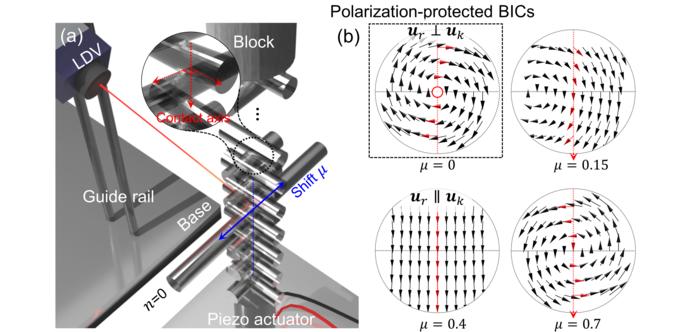In an extraordinary leap within the field of wave mechanics, a collaborative study spearheaded by researcher groups from Pohang University of Science and Technology (POSTECH) and Jeonbuk National University has successfully demonstrated the confinement of mechanical waves in a single resonator. This groundbreaking research, unveiled in the esteemed journal Physical Review Letters, is heralded as a significant breakthrough in understanding bound states in the continuum (BIC), a concept that has puzzled scientists for decades.
The quest to comprehend and manipulate mechanical waves is no trivial endeavor. Such waves are foundational to numerous technologies pervasive in our daily lives, whether it be smartphones, ultrasound equipment, or radios, where resonance plays a critical role. Though resonance—a phenomenal amplification of waves at designated frequencies—offers exciting applications, the typical resonators employed gradually lose energy, necessitating continuous power input to maintain effective functions. The potential for a system that can confine energy without leakage sparks the imagination and, now, scientific reality does not disappoint.
Delving into the past, historical figures like Nobel laureates John von Neumann and Eugene Wigner proposed a perplexing yet tantalizing idea over 90 years ago: the theoretical entrapment of waves, enabling their indefinite confinement without energy dissipation. Known as Bound States in the Continuum, these states serve as fascinating metaphors for whirlpools existing in flowing rivers. Despite extensive investigation, many believed the realization of BIC in compact, single-particle systems remained unattainable—until now.
Employing a strategically designed system consisting of cylindrical granular particles—essentially small quartz rods—the researchers constructed a finely tunable mechanical platform where the interaction of mechanical waves at contact points is under their precise control. By systematically adjusting the alignment of these cylinders, the team observed that under specific conditions, one could achieve complete confinement of a wave mode within a single cylinder without any energy escaping into the neighboring environment. This notable observation constitutes the first empirical evidence of a polarization-protected BIC, shattering long-held beliefs.
The implications of this discovery extend beyond merely trapping energy. Remarkably, the researchers succeeded in achieving exceptional quality factors (Q-factors) exceeding 1,000, a crucial metric that reflects how proficiently a resonator captures and stores energy while minimizing energy loss. This innovative achievement signifies not only a theoretical triumph but also a practical advancement in energy-efficient systems.
But what occurs when these special cylinders are interconnected to form a chain? The research team made a further remarkable finding—the trapped wave modes within individual cylinders could propagate throughout the chain without dispersing. This behavior is referred to as a flat band, an intriguing phenomenon suggesting that energy can travel without dissipating. Such movement bears striking similarities to throwing a pebble into a still pond, wherein the ripples remain stationary, oscillating only in place—a captivating visual of energy dynamics encapsulated in a Bound Band in the Continuum (BBIC).
Lead researcher Dr. Yeongtae Jang profoundly articulated the essence of their findings, stating that the experimentation reveals an ability to allow wave motion while simultaneously keeping energy precisely contained. This characteristic of perfect confinement paves the way for transformative applications ranging from energy harvesting devices to ultra-sensitive sensors, and even futuristic communications technologies.
The achievement of realizing BIC in a single cylindrical particle breaks long-standing theoretical barriers that have previously defined the limits of wave mechanics. Professor Junsuk Rho, leading the research group, emphasized the foundational importance of their findings, hinting at a future where low-loss energy systems could revolutionize technology. While emphasizing that the ongoing research remains rooted in fundamental exploration, the prospects for advanced sensing technologies and signal transmission systems appear tangible.
This trailblazing research receives support from the Mid-Career Research Program of the National Research Foundation of Korea (NRF), generously funded by the Ministry of Science and ICT, alongside the POSCO-POSTECH-RIST Convergence Research Center. The intersection of high-caliber academic investigation and cutting-edge technology fosters an environment ready to harness innovative capabilities unleashed by these scientific pursuits.
The accomplishment stands not only as a testament to the commitment of the research teams but also as a beacon of hope for future technologies, synthesizing the principles of theoretical physics and practical engineering in ways that could redefine our understanding of resonance and energy transfer. With the world increasingly reliant on efficient and sustainable technologies, the implications of this study are poised to resonate throughout various sectors, laying the groundwork for future innovations.
Ultimately, the intersection of rigorous academic endeavor and transformative practical application heralds a thrilling future for engineering and applied sciences. As research continues to unfold, society awaits the innovations that will arise from understanding and manipulating wave mechanics—with this study marking a fascinating chapter in that ongoing narrative.
Subject of Research: Bound States in the Continuum (BIC) in Mechanical Systems
Article Title: Bound States to Bands in the Continuum in Cylindrical Granular Crystals
News Publication Date: April 3, 2023
Web References: Link to DOI
References: Published in Physical Review Letters
Image Credits: POSTECH
Keywords
Mechanical energy, Mechanical systems, Resonance, Basic research, Fluid mechanics, Wave mechanics, Particle theory, Theoretical physics, Ultrasonic waves, Scientific publishing, Smartphones, Ultrasound, Signal amplification, Vortices, Particulate matter, Control theory.




